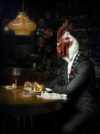With a career spanning over three decades, Nuno Correia has an impressive photography portfolio of food books, international chef collaborations, and food magazine features. And he’s a tabletop director. We sat down with Nuno to discuss his path to directing and the roots of his unique visual language.
Agnieszka Celej: Your works really stand out against other tabletop directors – you have your way of lighting, your way of camera movement, your way of storytelling. How did you find your own visual language?
Nuno Correia: My approach is what I’ve learned from photography. I’ve been a photographer since 1989 and that’s what I really like. I’ve started in sports photography – and I was a football photographer. They have 30 pages in GettyImages with my images with Spanish football, with the big stars that were playing at the time.
In photography, I think I got not to the top, but close, so I thought ‘ok, now that I’m good, I have a good team working with me, post production, etc., time to move to filming’.
And what I did was transporting what I achieved in photography into film. I did around 30 food books with several chefs, international chefs, I worked with food magazines as well. So that language, the photography language, I transplanted into tabletop. My goal is not to get to the perfection of tabletop like most directors do, where it almost touches CGI. I like it, but it’s not my way. My way is more organic, it’s more natural. The light, the approach, the food itself. So that’s why it turns out a little bit different.
I’m still doing photography – it’s my passion. Of course, I like filming too, but my real passion is photography.

A: So are you now a photographer half of the time and a director the other half?
N: Yeah, the balance is 50/50 I think. And I want to keep it that way, cause with filming, I think I’m at a very good level, I could maybe get a little bit better still.
What I do in photography supports what I do with film and vice versa. So it’s good to have them both balance each other out.
Jakub Laskus: It’s interesting, because it’s not that easy to switch between the two. It’s not just composition, it’s movement, physics. So is there any special approach you take? Or is it just intuitive and natural?
N: I think it’s intuition. When you’re shooting things with chefs and food, you are surrounded by people cooking. I’m very fast when shooting, I almost have it all in my head, you know? Plus, with my experience, it’s much easier now. But, with all the information I have from the past, from working with chefs, of their movements and what they do with real food – I think it’s intuition.
It’s not something that I plan or spend a lot of time trying to achieve. It’s intuition because I have a background in so many things regarding food and techniques.
J: In most cases you’re showing the beauty of natural food, meaning that you don’t do too many super sophisticated or abstract things. No abstract textures, no artificial feeling.
N: I prefer the things you can do in a more natural way. Most of my works don’t have any cleaning – I’m talking 80% of my films. I like the other styles too, and sometimes it’s impossible to do the natural thing – for example with chocolate. I remember in 2021 one of my clients wanted to do a natural shoot of a chocolate. In the end, with all the restrictions in their guidebook, it’s not that they had to do CGI but you had to do it almost looking CGI.

